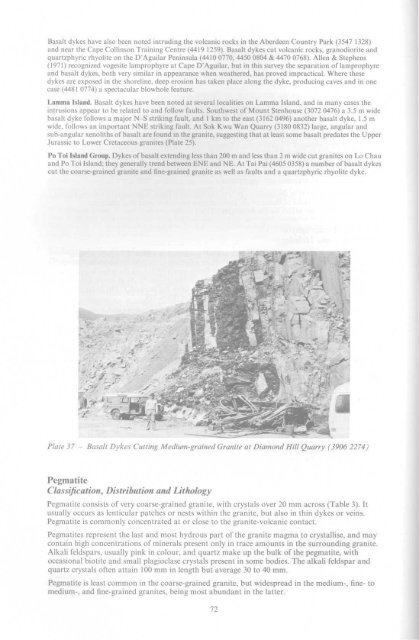Superficial Geology
Superficial Geology
Superficial Geology
Create successful ePaper yourself
Turn your PDF publications into a flip-book with our unique Google optimized e-Paper software.
Basalt dykes have also been noted intruding the volcanic rocks in the Aberdeen Country Park (3547 1328)<br />
and near the Cape Collinson Training Centre (4419 1259). Basalt dykes cut volcanic rocks, granodiorite and<br />
quartzphyric rhyolite on the D'Aguilar Peninsula (4410 0770, 4450 0804 & 4470 0768). Allen & Stephens<br />
(1971) recognized vogesite lamprophyre at Cape D'Aguilar, but in this survey the separation of lamprophyre<br />
and basalt dykes, both very similar in appearance when weathered, has proved impractical. Where these<br />
dykes are exposed in the shoreline, deep erosion has taken place along the dyke, producing caves and in one<br />
case (4481 0774) a spectacular blowhole feature.<br />
Lamma Island. Basalt dykes have been noted at several localities on Lamma Island, and in many cases the<br />
intrusions appear to be related to and follow faults. Southwest of Mount Stenhouse (3072 0476) a 3.5 m wide<br />
basalt dyke follows a major N-S striking fault, and 1 km to the east (3162 0496) another basalt dyke, 1.5 m<br />
wide, follows an important NNE striking fault. At Sok Kwu Wan Quarry (3180 0832) large, angular and<br />
sub-angular xenoliths of basalt are found in the granite, suggesting that at least some basalt predates the Upper<br />
Jurassic to Lower Cretaceous granites (Plate 25).<br />
Po Toi Island Group. Dykes of basalt extending less than 200 m and less than 2 m wide cut granites on Lo Chau<br />
and Po Toi Island; they generally trend between ENE and NE. At Tai Pai (4605 0358) a number of basalt dykes<br />
cut the coarse-grained granite and fine-grained granite as well as faults and a quartzphyric rhyolite dyke.<br />
/' :%> '<br />
- *3<br />
Plate 37 - Basalt Dykes Cutting Medium-grained Granite at Diamond Hill Quarry (3906 2274)<br />
Pegmatite<br />
Classification, Distribution and Lithology<br />
Pegmatite consists of very coarse-grained granite, with crystals over 20 mm across (Table 3). It<br />
usually occurs as lenticular patches or nests within the granite, but also in thin dykes or veins.<br />
Pegmatite is commonly concentrated at or close to the granite-volcanic contact.<br />
Pegmatites represent the last and most hydrous part of the granite magma to crystallise, and may<br />
contain high concentrations of minerals present only in trace amounts in the surrounding granite.<br />
Alkali feldspars, usually pink in colour, and quartz make up the bulk of the pegmatite, with<br />
occasional biotite and small plagioclase crystals present in some bodies. The alkali feldspar and<br />
quartz crystals often attain 100 mm in length but average 30 to 40 mm.<br />
Pegmatite is least common in the coarse-grained granite, but widespread in the medium-, fine- to<br />
medium-, and fine-grained granites, being most abundant in the latter.

















